For a station with as storied a history as Grand Central Terminal, there’s bound to be a few hoaxes or tall tales shared over the years. The best stories always begin with a kernel of truth, to lay a believable foundation to imagine from. In the case of Grand Central’s sub basement, known as M42, a tall tale has sprung a life of its own. Just search for M42 online and you will read stories of a “clandestine” or “top secret” basement that “Hitler tried to destroy.” In reality, most things you’ve heard about M42 are probably false. The fictional story has been told so many times, and like a game of telephone, the claims have grown more extravagant over the years. In some cases the claims are even contradictory, depending on who tells the tale. Hopefully we can set the record straight, and finally put this oft-repeated myth to rest.
Claim: The M42 substation that powered the Terminal opened when Grand Central did in 1913.
Truth: The original electric power conversion substation was located at 50th Street and was moved underneath the Graybar Building in 1929 so that the air rights could be sold to build the Waldorf Astoria.
About ten stories below the ground, deep underneath Grand Central lies its basement, known by the top-secret-sounding name M42. The designation refers to the basement itself, not the substations (of which there were two), but in public consciousness they are synonymous. The name is more modern in nature, as no historical texts use this designation for the supposedly secretive place. Initially the small space was used for two boilers that heated the Terminal during the colder months. Once the railroad signed an agreement with the Waldorf Astoria in 1929, however, they quickly enacted a plan to move the unsightly substation above ground at 50th Street. The small underground space was greatly expanded by digging out a large section lying directly underneath the Graybar Building. Equipment from the old substation was painstakingly dismantled, lowered to track level, transported underground, and then lowered further again to arrive at the new location. The largest size rotary of 4,000 kW weighed 68 tons, and required about 90 days to take apart, move and then reassemble and install.
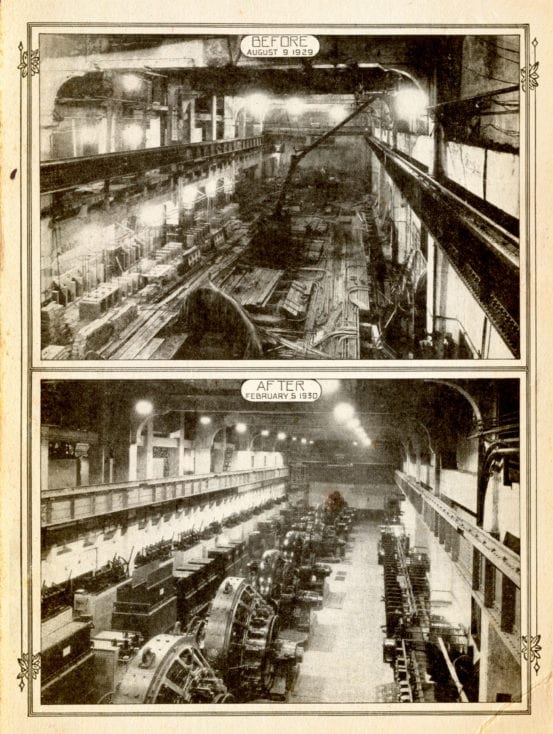
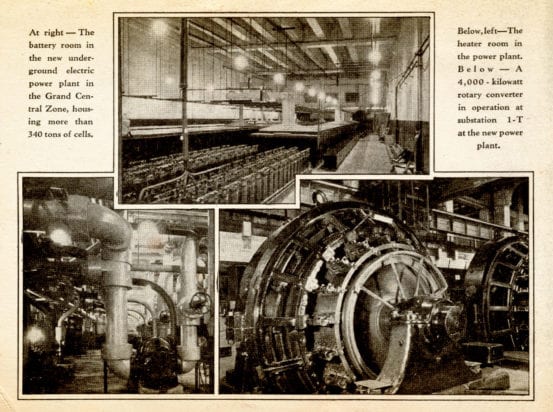
Claim: There were only two spies.
Truth: The real-life operation to damage infrastructure had a total of eight spies.
Many people find the story of Nazis in Grand Central to be so believable, largely because bits of truth have been woven into the tale. Although their missions never included Grand Central as a target, there were truly two instances of spies sent from Germany to the United States in U-boats during World War II – Operations Pastorius and Magpie.
Some retellings of the Grand Central sabotage story put the spies as members of Operation Pastorius, which had eight members. This is the most plausible, as the operation did have targets in New York, including railroad infrastructure, although the primary goal was disrupting aluminum production. Other versions of the tale say there were only two spies, corresponding more closely to Operation Magpie, which occurred two years after Operation Pastorius. For Magpie, two Nazi spies were sent to Maine to gather intelligence on American factories, shipyards, testing facilities, and whether Nazi propaganda seemed to have any affect on the populace. That operation ended as similarly as the first, with one of the participants surrendering to the FBI. Neither operation included sabotaging the substation at Grand Central, but gave the tale its air of truth.
Claim: The sabotage was to prevent the United States from entering the war.
Truth: The United States had already declared war on Germany.
Pearl Harbor was attacked by the Japanese on December 7, 1941, leading to the US to declare war on Japan. Germany, as allies to Japan, declared war on the United States on the 11th of December, 1941. Later that day the United States reciprocated by declaring war on Germany.
Hitler’s pact with Japan required them to come to Japan’s aid if they were attacked by another power, but Germany was not required to declare war if Japan started the conflict. The decision by Hitler to declare war, often seen as illogical by historians, allowed the US to enter the European theatre with little opposition from the populace.
Operation Pastorius occurred in June of 1942, and Magpie in September 1944, both after Germany’s declaration of war had drawn the United States into the conflict. Hitler was said to have directly ordered some type of sabotage himself, telling the Abwehr “to finally do something in America.”
Claim: The rotary converters at M42 were a target of Nazi saboteurs.
Truth: As part of “Operation Pastorius” several American factories and railroad targets were selected for sabotage by Nazis, but neither Grand Central nor M42 were named as targets.
Many tales from World War II are indeed captivating, but none more so to Americans than the misadventures of Nazis on our own soil as part of Operation Pastorius. In June 1942 two teams of Nazis landed on American beaches at Long Island and Florida in U-boats with the goal of disrupting wartime aluminum production. Trained at a sabotage school outside Berlin, the two teams of four men each had a list of targets to attack, including factories and railroad infrastructure.
Sam Roberts, in his book Grand Central: How a Train Station Transformed America, attempts to debunk several myths but is relatively generous while addressing this subject, essentially stating that Grand Central as a target could have been plausible, considering that one of the saboteurs’ goals was to disrupt train movements. That is true to a point – there were several named primary targets, and then there were secondary goals which included causing terror by bombing Jewish-owned shops, and putting bombs in train station lockers to induce panic.
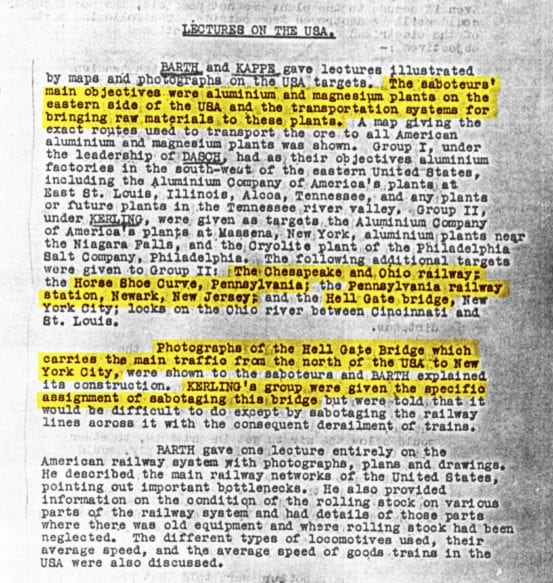
The truth of the matter is that Operation Pastorius is extremely well documented. No less than five books have been authored recounting the details, including a first hand account by leader of the Long Island team and whistleblower George John Dasch. In addition to those sources there are declassified transcripts of the testimony at the military tribunal held after all eight saboteurs were caught, as well as an extensive report from MI5, UK’s intelligence agency. Not a single one of these sources ever mentions Grand Central as a target. Hell Gate Bridge? Yes. Newark Penn Station? Yes. Horseshoe Curve? Yes. But neither Grand Central nor M42 are ever named, and neither is throwing sand on a rotary converter.
In terms of “disrupting railroads” reports and confessions are clear in what the saboteurs learned, and how they planned to enact this sabotage. It included bombs that looked like other materials, including coal and writing utensils, damaging locomotives by introducing abrasives into their lubrication systems, and derailing trains carrying raw materials to and from the essential wartime aluminum factories that were the primary goal of the operation. Cryolite and magnesium plants were also targeted due to their usage in producing aluminum. Aluminum, considered vital for national security (even to this day), was used for many wartime applications, but notably was the primary material necessary for aircraft production.
During World War II, railroads carried 90% of the military’s freight, and 98% of its personnel. As a major coal hauler, targeting the Chesapeake and Ohio would disrupt the delivery of the essential fuel that powered wartime factories. Taking out the Hell Gate Bridge would cut off New York City’s direct railroad line to factories of aircraft engines, helicopters, and submarines in Connecticut. Bombing the tracks at Newark would cut New York City’s rail link at the opposite end, as well as interfere with troop and supply movements. Some of the largest staging areas for the war effort were located alongside railroad lines in New Jersey, including Camp Kilmer for troops, and Belle Mead for supplies. Pittsburgh, which produced more steel for the war effort than all the Axis powers combined, would be blocked from reaching Philadelphia and eastern ports across the Pennsy’s main line if Horseshoe Curve was successfully damaged. In most cases the detriment of any sabotage would be short lived – bombed tracks could be quickly rebuilt, or trains could be rerouted on alternate trackage.
Claim: A simple bucket of sand could entirely disable the electrical system.
Truth: Ten rotary converters and backups would keep the system going.
When the electrical system for the New York Central was constructed, care was used to create, as described by General Electric, “[infrastructure that was] doubly insured against failure.” Power was generated at two different stations, one at Glenwood, and another at Port Morris. The rotary converters at M42 predecessor 50th Street were one of nine such substations designed to step down the high pressure 11,000 volt alternating current from the generating plants and convert it to the 600 volt direct current that powered the third rail.
When opened in 1930, the equipment housed at M42 was responsible for illuminating more than 100,000 electric lights, moving more than 650 trains daily, operating 325 elevators in 28 buildings, and supplying those buildings with heat and hot water. There were a total of ten rotary converters, three more than were located at the previous 50th Street substation. Technically the basement was split into two separate substations – the eastern portion, 1T, powered the third rail system, and the eastern half, dubbed 1L, provided the power necessary for the station and nearby buildings. In addition, there was a battery backup consisting of 160 cells, each 7 feet long and weighing over 4,500 pounds, which could each provide power to the buildings for a short time in the event of a failure.
Say you did manage to get down to M42 with a bucket and threw it into one of the rotary converters. According to Robert Lobenstein, retired General Superintendent of Power Operations at New York City Transit (which used similar rotary converters to power the subways), the sand would “likely destroy the brushes on both the AC and DC sides of the rotary, and rough up the commutators and slip rings. If somehow the sand got into the bearing caps, the machine would be rendered useless until parts were replaced and sand was flushed from the oil reservoirs.” He notes that materials other than sand thrown into an operating rotary could potentially lead to a massive “flashover” that would knock the saboteur off their feet and result in “a short circuit on the DC side leading to a ring of fire on the commutator, destroying coils and throwing molten lead solder around the room.”
Although temporary damage to the rotary from the sand was likely, it was also possible that if not enough sand was thrown into the machine it could have just spun off and kept going. Whatever the result, (even in the case of a major flashover) capable railroad employees could dismantle the massive machinery and replace any fried parts with spares or items that they fabricated, eventually restoring the rotary to service.
Remember, though, M42 had a total of ten rotaries. A bucket of sand would only take out a single one, so at most you’ve only succeeded in reducing the output capacity of the substation. All five of the rotary converters used to power the third rail had a total capacity of 16,500 kW, and before being moved to M42, the converters at the previous substation had a slightly lesser combined capacity of 14.500 kW. And when that substation was first put into service it only had a 6,000 kW capacity. The trains had before and could again operate with reduced capacity. Losing one converter, even if it was one of the larger 4,000 kW machines, would not cause a serious detrimental affect on the system.
Ultimately, in order to completely halt traffic through the Terminal you would need more than one bucket of sand. All four saboteurs, with a bucket of sand each, would greatly reduce capacity, but still wouldn’t completely disable the system. They’d have to invite a fifth friend to go play in the sandbox with them.
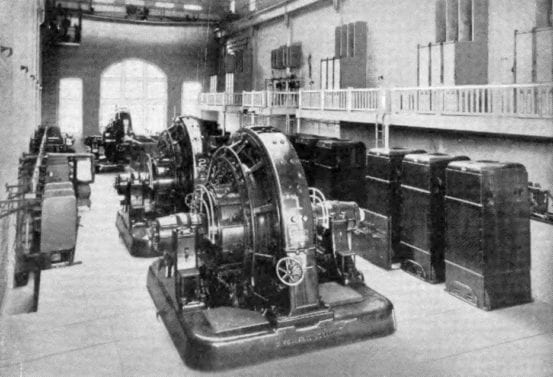
Claim: Taking out M42 would cripple all train movement in the Northeast.
Truth: M42 was a small piece of a larger electrification network, and most trains would operate as normal.
Grand Central and the lines running from it were part of an entire electric zone – the Hudson division was electrified to Croton, a distance of 34 route miles, and the Harlem division was electrified for 24 route miles, ending at White Plains (with a total electrified trackage of 251 miles). Two generating stations provided all power to the electric zone, and nine substations converted the power and distributed it to the third rail for use by trains. Besides the substation in the basement of Grand Central, the other substations were located along the tracks at Mott Haven, Kingsbridge, Yonkers, Irvington, Ossining, Botanical Garden, Tuckahoe, and White Plains. These eight substations contained 32 total rotary converters, and provided a total capacity of 49,000 kW.
If one did manage to successfully disable the two substations at M42, there is no doubt that it would cause issues. The Terminal, as well as several nearby buildings and hotels, depended on the power from these substations. In the case of the third rail, the next closest substation – #2 at Mott Haven, approximately five and a half miles away – would attempt to back feed DC power to Grand Central. Trains would have to operate at reduced speeds as to not overload the system, meaning there is no guarantee that even trains in the station would come to a complete standstill. As the system was built with redundancy in mind, the failure of one substation should not have adversely affected the operation of the entire electric zone in normal cases. Grand Central was a special case, however, as its substation carried a heavier load than all the rest, and was located at the end of the line.
The thought that disabling M42 would cripple all trains in the Northeast is a gross over exaggeration. The “Northeast Corridor,” which some stories specifically name, is not even connected in any way to Grand Central, and would be wholly unaffected. Other sources use the terminology “Eastern Seaboard” which is also entirely incorrect. The only place that would potentially feel any affect would be Grand Central itself. The remainder of the electrified zone had its own substations to keep running normally, and beyond that zone trains were operated by steam engines, which would also be unaffected by any electric sabotage.
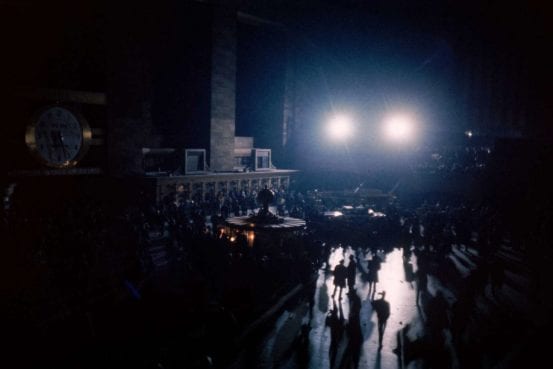
Claim: The Nazi saboteurs that landed by U-boat were caught after they tried to check a bag at Grand Central, or were arrested in Grand Central.
Truth: The eight saboteurs were caught because one of them confessed to the FBI almost immediately after arriving on American shores, and before any sabotage was carried out.
Leader of the New York team, George John Dasch, called the FBI very soon after arriving in New York City, having taken the Long Island Rail Road from their landing point of Amagansett, on the southeast end of Long Island. Although the call was initially thought a joke, a few days later he boarded a train for Washington DC intent on meeting with the FBI in person. He described himself as, “not an American agent in the legal sense, but a fighter against Hitlerism and determined to have this mission blow up right in Hitler’s face.” Dasch maintained that he had decided to expose the mission as soon as he was asked to complete it, before even arriving in the United States. He viewed his return to Germany after living in the United States for many years a mistake, and thought the mission would be the only way he could return without raising suspicion, all while performing a heroic act to boot. Alternately, some in the FBI were skeptical and posited that Dasch only had a change of heart upon landing on American shores. Irrelevant of when he decided to talk, it was Dasch’s confession (which initially was not even believed until he showed off the large piles of cash that were provided to him to complete the mission) and the assistance of fellow Long Island landing team member Ernst Peter Burger that spoiled the plot and led to the capture of all operatives. All of the saboteurs, with the exception of Dasch and Burger, were quickly executed by electric chair after a military tribunal within two months of arriving from Germany.
The spies were not arrested in Grand Central, nor were they found because of anything they did in Grand Central – claims that differ depending on who tells the tale. Most of the spies probably never even went to Grand Central during the mission, as the New York team used the Long Island Rail Road and Penn Station. Thiel and Kerling of the Florida landing team made their way through the Grand Central, but only because they imagined direct trains from Florida were being watched, so they opted to take a roundabout journey to New York via Cincinnati. They subsequently checked in to the nearby Commodore Hotel and in truly suspenseful fashion, promptly fell asleep. Later Thiel did meet an old friend at the Terminal, at the famous information booth – the only times Grand Central is mentioned in the testimony.
Claim: One of the Nazi spies worked in Grand Central.
Truth: All of the saboteurs had lived in the United States previously, but none were employed at Grand Central.
George John Dasch was a complicated fellow. He had lived in the United States for eighteen years after illegally entering at the port of Philadelphia as a stowaway. Married to an American woman, he had been employed as a waiter in New Rochelle, a role his mother found demeaning. Even worse, Dasch had been unemployed for several months and rendered nearly penniless after becoming embroiled in a legal battle with a local labor union. This destitution made it easy for Dasch’s mother to ultimately convince him to return to Germany, with a promise that not only could a family member get him a better paying skilled job, but also with the assurance that everything at home was normal, better than normal, even, and as long as he kept to himself the Nazis would have no interest in him.
Returning to Germany directly from the United States was not possible at the time, so Dasch took a multi-week trek through Japan, China, and Russia to reach home, a trip sponsored by the German embassy. Upon return, Dasch worked for several months translating American radio broadcasts, but observed that things were not really better – he felt the populace had been rendered quasi slaves, unable to think for themselves. And contrary to his mother’s thoughts, the Nazis were quite interested in Germans having returned from the US, thinking that their familiarity with the country and language would prove an asset for sabotage missions. Being invited to participate aligned with his goal of trying to get out of Germany – under the eye of the Gestapo, attempting to flee would have been nearly impossible otherwise.
Each of the chosen saboteurs had their own unique stories, but shared the collective experience of having lived for several years in the United States working menial jobs before returning to Germany for one reason or another. Haupt was a 22 year old who came to live in Chicago as a preschooler, spoke English better than he did German, and was an American citizen. Quirin had lived in the US for 13 years, and worked as mechanic for GE in Schenectady until he was laid off during the Depression. Burger had become a naturalized American citizen, and worked in both Milwaukee and Detroit as a machinist, and later as an artist. He did a seventeen month stint in a concentration camp upon his return to Germany after writing a paper critical of the Gestapo. Heinck had come to the United States illegally, and worked odd jobs in New York City including busboy, handyman, and elevator operator. Kerling likewise worked odd jobs in the New York area, including at a meat packing facility in Brooklyn and as a handyman in Mount Kisco. Neubauer had lived in Chicago and Miami for nine years, working as a cook. He was drafted into the German army after returning home to visit family. Thiel worked as a machinist for Ford in Detroit, was a porter in New York, and performed other odd jobs throughout his journeys to Illinois, California, and Florida. None of the eight had ever worked in Grand Central or for the railroad in any capacity.
Claim: The existence of M42 was considered top-secret and only became public knowledge in the 1980s.
Truth: The New York Central Lines, and General Electric, were rather proud of the substation – photos and details of it were published in several newspapers and magazines.
If you had just managed to move an entire substation with equipment that weighed a total of 850 tons according to schedule, without damaging a thing, all while operating continuing, uninterrupted train service you’d probably be pretty proud too! When Grand Central’s electric system first went online General Electric released a promotional book called “Electricity on the New York Central” which gave descriptions of the system, the new electric locomotives, as well as the rotary converters. It contained photos of the original substation at 50th Street, as well as substation #5 at Irvington (seen above). The rotaries and where they were located was not at all a secret.
After the move, the two substations at M42 were also not a secret. The March 1930 edition of the New York Central Lines Magazine contained an article titled “Moving Terminal Power Plant Engineering Feat.” An article entitled, “Metal Roots That Feed the Living City” appeared in the April 13, 1930 edition of the New York Times, containing a picture of the substation under construction and a description of the move. June 1930’s Scientific American likewise had a story, entitled “Moving a Substation Underground.” The article contained before and after pictures, as well as thorough descriptions of the move and an explanation of the equipment found within. General Electric also had an advertisement that ran in several magazines in the 1930s boasting the new Grand Central Substation as “one of the most remarkable substations in existence.” Not only does the ad show a picture of the room, it details what equipment is in the substation, and for anyone who might be unsure as to where the substation is located, actually contains a photo at street-level of the Graybar Building and states that it is 100 feet under its sidewalk. Considering all the publicity at the time, the idea that the substation was considered classified information until the modern era is a complete fabrication.
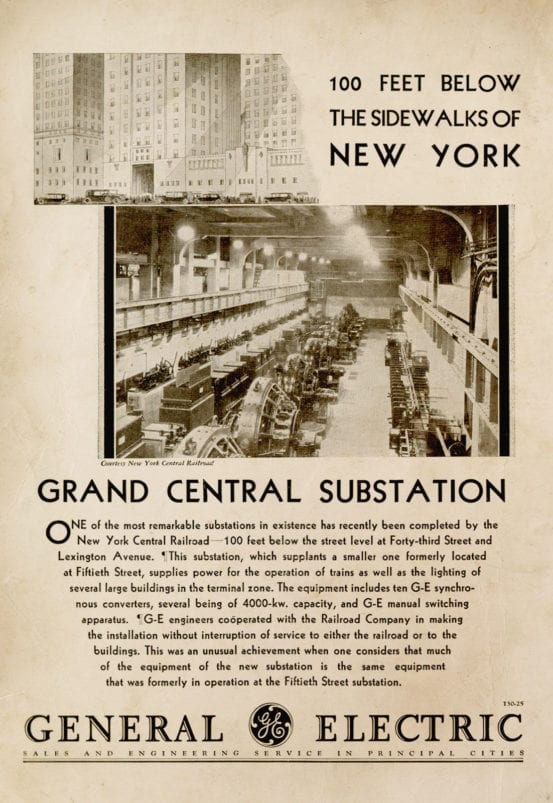
Claim: Dasch was viewed a hero for foiling the sabotage plot.
Truth: Dasch was jailed and deported.
This one isn’t actually part of the Grand Central tale – but if for some reason you thought that Dasch would receive a hero’s welcome for exposing the saboteurs, you would be wrong. Despite promises of a presidential pardon, Dasch was jailed until the war was over and then deported to the then-partitioned Germany. He continued to seek a pardon so he could return to the United States, but it was never granted. In 1959 he wrote his own account of the events of Operation Pastorius, titled Eight Spies Against America. He moved frequently due to being seen as a traitor by his neighbors, and died in the early ’90s.
In closing, Grand Central is, of course, an important place. But it does not have to be at the forefront of every story, nor woven into every New York historical happening. There are enough legitimate tales within the walls of Grand Central to keep any storyteller busy for ages – we need not continue telling fantastic fables.
Special thanks to Bob Lobenstein for graciously sharing his knowledge with me and answering my silly “what if” questions about rotary converters!

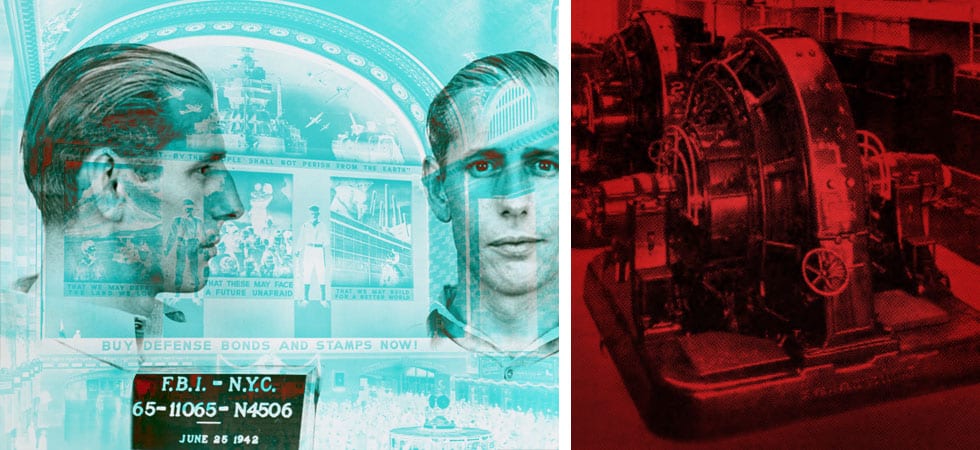
Emily,
So nice to have gotten a new e-mail from “I Ride The Harlem Line”. One thing has always amazed me. Evidently, the New York Central had enough lead acid batteries to operate the railroad for an hour in the event of a complete power failure.
Thanks for the positive thoughts! The battery acid was actually a big issue when moving the substation, and largely why everything happened underground. The city did not permit moving the acid aboveground, so the railroad had to figure out how to move it below.
Around 2000 or maybe earlier I watched a “ WW2 Nazi spies documentary” on one of the history channels or the military channel that made all kinds of claims about this purported Grand Central sabotage attempt. Up until now I assumed it was all true. Thanks for the corrections.